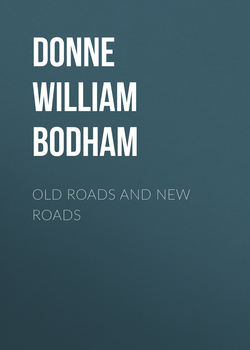Old Roads and New Roads

Реклама. ООО «ЛитРес», ИНН: 7719571260.
Оглавление
Donne William Bodham. Old Roads and New Roads
PREFACE
OLD ROADS AND NEW ROADS
Отрывок из книги
We have histories of all kinds in abundance, – and yet no good History of Roads. “Wines ancient and modern,” “Porcelain,” “Crochet work,” “Prisons,” “Dress,” “Drugs,” and “Canary birds,” have all and each found a chronicler more or less able; and the most stately and imposing volume we remember ever to have turned over was a history of “Button-making:” you saw at once, by the measured complacency of the style, that the author regarded his buttons as so many imperial medals. But of roads, except Bergier’s volumes on the Roman Ways, and a few learned yet rather repulsive treatises in Latin and German, we have absolutely no readable history. How has it come to pass that in works upon civilization, so many in number, so few in worth, there are no chapters devoted to the great arteries of commerce and communication? The subject of roads does not appear even on that long list of books which the good Quintus Fixlein intended to write. Of Railways indeed, both British and foreign, there are a few interesting memorials; but Railways are one branch only of a subject which dates at least from the building of Damascus, earliest of recorded cities.
Perhaps the very antiquity of roads, and the wide arc of generations comprised in the subject, have deterred competent persons from attempting it; yet therefore is it only the more strange that incompetent persons have not essayed “this great argument,” since they generally rush in, where their betters fear to tread. A history of roads is, in great measure indeed, a history of civilization itself. For highways and great cities not merely presuppose the existence of each other, but are also the issues and exponents of two leading impulses in the nature of man. Actuated by the one – the centripetal instinct – the shepherd races of Asia founded their great capitals on the banks of the Euphrates and the Ganges: impelled by the other – the centrifugal instinct – they passed forth from their cradle in the Armenian Highlands, westward as far as the Atlantic, and eastward as far as the Pacific. We have indeed indications of roads earlier than we have accounts of cities. For ages before Arcadian Evander came as a “squatter” to Mount Palatine, was there not the great road of the Hyperboreans from Ausonia to Delphi, by which, with each revolving year, the most blameless of mankind conveyed to the Dorian Sun-god their offerings? And as soon as Theseus – the organizer of men, as his name imports – had slain the wolves and bears and the biped ruffians of the Corinthian Isthmus, did he not set up a direction-post, informing the wayfarer that “this side was Peleponnesus, and that side was Ionia”? Centuries of thought and toil indeed intervened between the path across the plain or down the mountain-gorge and the Regina Viarum, the Appian Road; and centuries between the rude stone-heap which marked out to the thirsting wayfarer the well in the desert, and the stately column which told the traveller, “This is the road to Byzantium.”
.....
In many cases indeed the Roman cities were allowed to decay: the forest resumed its rights: the feudal castle was constructed from the ruins of the Proconsul’s palace and the Basilica, or if these edifices were too massive for demolition, they were left standing in the waste – the Mammoths and Saurians of a bygone civilization. The great Viæ were for leagues overgrown with herbage, or concealed by wood and morass; and for the direct arms of transit which bound Rome and York together as by the cord of a bow, were substituted the devious and inconvenient highways, which led the traveller by circuitous routes from one province to another. The contrast indeed between the ‘Old Road and the New’ is represented in Schiller’s fine image – rendered even finer in Coleridge’s translation: —
It was long however before much security was found on the new roads. In the dark ages the days described by Deborah the prophetess had returned. “The highways were unoccupied, and the travellers walked through bye-ways: the villages were deserted. Then was war in the gates, and noise of the archers in the places of drawing water.” Danger and delay were often the companions of the traveller. Occasionally a vigorous ruler, like Alfred, succeeded in restoring security to the wayfarer, and proved his success (so said the legend) by hanging up, in defiance of the plunderer, golden armlets on crosses by the roadside. But these intervals of safety were few and far between, and the traveller journeyed, like Coleridge’s Ancient Mariner, “in fear and dread,”
.....